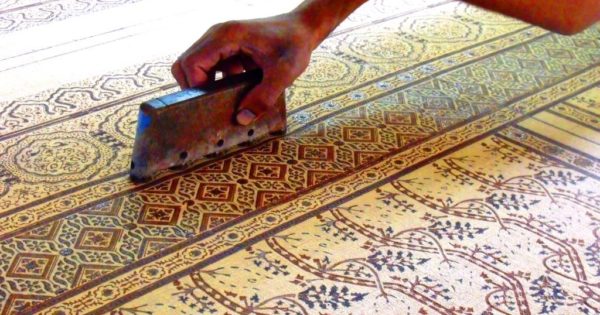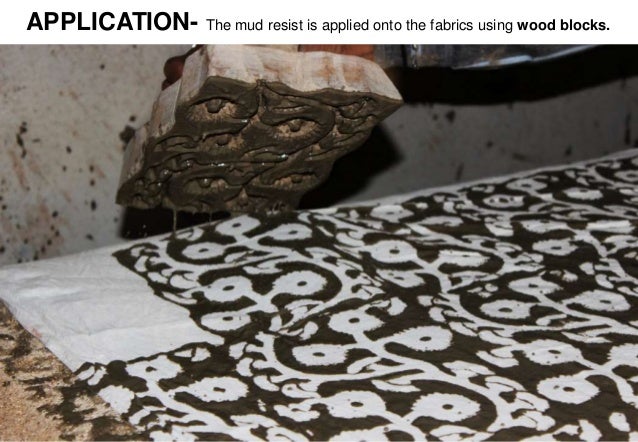
Bagru printing is one of the traditional techniques of printing with natural colour followed by the chippas of a remote place of Rajasthan. Bagru is a small village located near Jaipur, the capital City of Rajasthan. It’s home to the Chippa community who have been practicing a unique style of printing for more than 350 years.
The process starts from preparing the cloth to finished printed fabrics through their indigenous methods. Motifs having some specialty are transferred onto light coloured background with wooden blocks following two styles – direct and resist style.

Although this technique is facing problems against the threat of globalization, this exotic art of creation is required to be encouraged in the present context of environmental consciousness.
Bagru printing is a manual process through which they fabricate some of the most amazing bed covers, kurtis, ghagras and other materials. They block impression prints repeatedly. A little different placement of the next block is the main beauty of this art.
There is no authentic record for reference on backdating Bagru's block printing practices and there prevail different opinions behind its starting. However, it is estimated that this art form was introduced 450 years back when a community of Chhipas (literally meaning people who stamp or print) came to Bagru from Sawai Madhopur (Alwar), and settled in Bagru. Even today, their community works together in a place called Chhippa Mohalla (Printer's Quarters) by the Sanjaria riverside. It is perhaps the river name that lends it name to Sanganeri printing art form. The Chippas community settled along the riverside, like any other nomadic settlement. The bank of the river provided them with clay which is an important ingredient in getting the base color of the famed 'Bagru' prints.

According to the opinion of other group, the tale unfolds more than 400 years ago when the Thakur on the lease of the village decided to develop Bagru as a centre for block printing and brought two families of printers from Isarda3, a village near Jaipur. The printers locally known as 'Chippa' came from the loyal patronage. The presence of abundant water in the overflowing 'Sanjaria' river and its clean sunny river bed led to the settlement of the Chippas. Today though the river runs dry these artisans thrive in Bagru practicing their same methods of the past thus ensuring survival of the traditional art.

Around 5 decades back, Bagur prints were limited to ghagras and cholis for women of their own community. They also used to sell them in their local market. Earlier, these prints were used to identity Hindu castes, like leather workers used to wear the same print as blacksmiths. However, the base color differentiated them.
Thanks to these fabulous prints, Bagru has made its own space in the international fashion. Today, they are highly used in contemporary fashion. Their indigo color with beautiful block patterns and motifs in kurtis, pants, skirts, jackets and more, appeals to many Indians. It will not wrong if we say that summer conventional fashion is incomplete with Bagru prints. Other than fashion, Bagru prints are immensely used in home furnishing items and accessories.
• Block printing is done on both cotton and silk fabrics of varying counts. The fabric requires a pre-printing treatment where the fabric to be printed is washed free of starch and soft bleached if the natural grey of the fabric is not desired. If dyeing is required as in the case of sarees, where borders or the body is tied and dyed, it is done before printing.
• The fabric is stretched over the printing table and fastened with small pins
Each table now may have multiple block printers working simultaneously on imprinting the fabric depending upon the intricacies of the design.
• The block printer pushes along small wooden trolleys with racks that have castor wheels fastened to their legs to facilitate free movement as he works. On the upper most shelf trays of dye are placed. On the lower shelves printing blocks are kept ready. These blocks are then dipped in dye and imprinted on to the fabric by a skilled block printer.
• The printing starts from left to right. The color is evened out in the tray with a wedge of wood and the block dipped into the outline color (usually black or a dark color).
• When the block is applied to the fabric, it is slammed hard with the fist on the back of the handle so that a good impression may register. A point on the block serves as a guide for the repeat impression, so that the whole effect is continuous and not disjoined.
If it is a multiple color design the second printer dips his block in color again using the point or guide for a perfect registration to fill in the color. The third color if existent follows likewise.
• Skill is necessary for good printing since the colors need to dovetail into the design to make it a composite whole. A single color design can be executed faster, a double color takes more time and multiple color design would mean additional labor and more color consumption.
• Different dyes are used for silk and cotton.

Synthetic dyes have come out from traditional style of hand block printing in Bagru and making the prints more attractive. This art is not only magnificent but also Eco friendly so gaining more importance as the world is rising up for environmental awareness and getting renowned day by day.
Storage Tips to Keep Hand Block Printed Textiles Fresh for Years
January 16th, 20265 Reasons Hand Block Printed Quilts Belong in Every Winter Bedroom
January 10th, 2026New Year, New Vibe: Refresh Your Home with the Magic of Hand Block Prints
December 26th, 2025Why Sustainable Home Décor Buyers in the UK Are Choosing Indian Textiles
December 24th, 2025